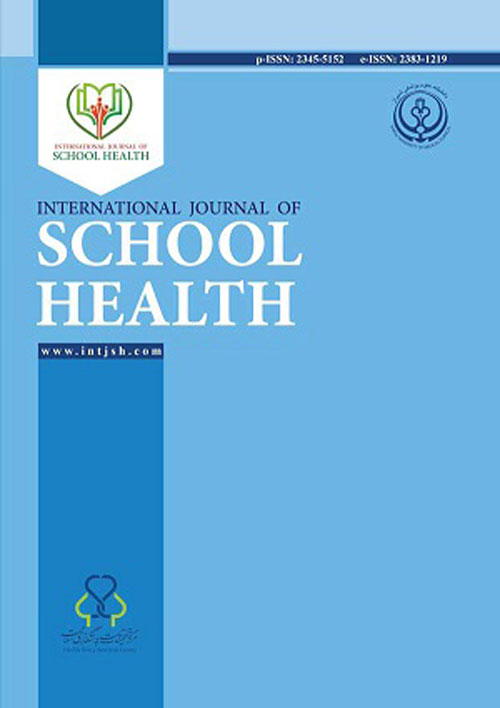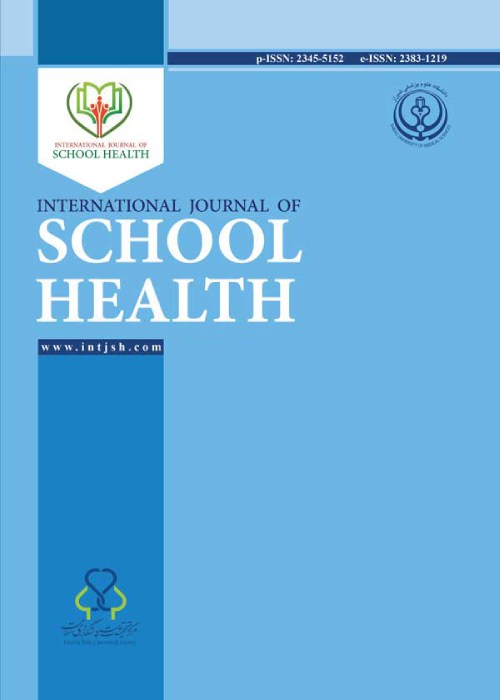فهرست مطالب

International Journal of School Health
Volume:3 Issue: 1, Winter 2016
- تاریخ انتشار: 1394/11/15
- تعداد عناوین: 7
-
-
Page 1BackgroundAdjustment and coordination with environment is indispensable to all people.ObjectivesThe aim of present study was to determine the effectiveness of solution-focused brief therapy in increasing adjustment of high school female students.Materials And MethodsThis study was based on an experimental pretest-posttest design including 30 female students of Amol high school in academic year 2011 - 2012.The participants were selected by purposive non-convenience sampling methods, randomly assigned to experimental and control groups, who completed the Bell’s adjustment questionnaire in pre-test phase. Thirty subjects with scores close to mean were selected and randomly divided into control and experimental groups. Solution-focused brief therapy intervention for experimental group was carried out in 5 sessions followed by performing posttest on the two groups. The data obtained were then analyzed using MANCOVA.ResultsThe results showed that solution-focused brief therapy (SFBT) was effective in increasing adjustment of the students (P < 0.0006), as well as increasing 3 subscales of adjustment questionnaire comprising home adjustment (P < 0.0006); health adjustment (P < 0.0006); and social adjustment (P < 0.0003); but had no effect on affective adjustment (P < 0.081).ConclusionsConsidering the significant effect of SFBT interventions on increasing adjustment in young students, the training of school counselors can be an effective means for youth to achieve their goals and decrease some problems in the community.Keywords: Adjustment, Solution, Focused Brief Therapy, Female Students
-
Page 2BackgroundContamination by pollutants has been considered as one of the environmental concerns during the recent years. Lead is one of the most common industrial contaminants all over the world and increase in lead level is associated with behavioral and cognitive problems. Attention deficit hyperactivity disorder (ADHD) is among the most common psychological-behavioral disorders among children, with the incidence rate of 4% - 12%.ObjectivesThis study aimed to investigate the relationship between serum lead level and ADHD through comparison of serum lead level between children with ADHD and the control group.Patients andMethodsThis case-control study was conducted on 20 children with ADHD and 23 healthy children in the control group. The serum Lead level measured by an atomic absorption spectrometer, equipped with graphite furnace system, was compared between the two groups. The data were analyzed using the SPSS statistical software, version 16.ResultsThe mean level of serum lead was higher in the ADHD children (6.7330 ± 2.39747) compared with the control group (3.0304 ± 1.30573) (P = 0.001). However, no significant difference was observed between the two genders regarding the mean level of serum lead in the case (P = 0.088) or the control group (P = 0.365).ConclusionsBased on the study results, the mean level of serum lead was significantly higher in the ADHD group in comparison to the control group (P < 0.001). Thus, environmental contaminants, such as lead, can be associated with increasing incidence of ADHD. Yet, further studies on larger sample sizes are recommended to confirm our findings.Keywords: ADHD, Children, Graphite Furnace, Serum Lead Level
-
Page 3BackgroundThe worldwide prevalence of malnutrition which is the root cause of many health problems, and presented as underweight and overweight, has increased in past decades. Therefore efforts are required to prevent malnutrition and its associated complications.ObjectivesThe present study aimed to assess the relationship between nutritional status and some socio-economic factors in elementary school children in Shiraz, Iran.Materials And MethodsThis cross-sectional study was performed on 740 primary school students in Shiraz selected through cluster random sampling. The data consisted of personal characteristics, including demographic features, education grade, height, weight, birth order, number of children in the family, parents’ age, parents’ education levels, parents’ occupation, immigration history, divorce, birth weight, breastfeeding period, birth season, history of obesity in the first degree relative, sleep duration, time spent on watching TV, using computer, and playing video games, eating meal and pre-meal patterns, and economic status. Besides, the students’ Body Mass Indices (BMI, weight (kg)/height × height (m2)) were measured in order to determine student’s percentiles.ResultsThe study results revealed that 73 (9.9%), 524 (70.8%), 101 (13.6%), and 42 (5.7%) students were underweight, normal, overweight, and obese, respectively. Among the evaluated factors, only mid-afternoon meal was significantly related to nutritional status. In comparison to having more than two pre-meals a day, not consuming afternoon pre-meal increased the chance of being underweight by about 10.1 folds. Moreover, the chance of being underweight increased in children who did not consume afternoon pre-meal due to less energy intake.ConclusionsThis study revealed a high prevalence of malnutrition among the primary school students. Yet, further studies are required to accurately identify the effective factors for prevention and treatment of malnutrition in school age children.Keywords: Nutritional Status, Socioeconomic Factor, Child
-
Page 4BackgroundPhysical activity is now widely accepted as a measure to reduce stereotypic behaviors in children with Autism Spectrum Disorder (ASD). However, several issues exist concerning the effects of physical activity on stereotypic behaviors, such as inconsistency with research methodology. The present study which was different from previous investigations as it attempted to address those issues because it classified the intensity of physical activity using heart rate, monitored the children’s behavior over a span of 4 hours after physical activity and documented how long stereotypic behavior reduction lasted. The regimented exercise routine was also enriched with fun and motivational activities.ObjectivesThe purpose of this study was to examine the effects of physical activity on stereotypical behaviors of children with ASD.Patients andMethodsThe present study was comprised of 23 children aged from 5 to 11 years, who participated in 15 minutes of moderate to vigorous physical activity (MVPA). Physical activity was identified as moderate or vigorous based on the child’s heart rate. Participants were observed for a period of 2 hours before and after 15 minutes engagement in MVPA and their behaviors were then classified as either stereotypic behavior (SB) or task-engaged behavior (TE). A 2 (gender) x 3 (disorder) repeated measures ANOVA was conducted on pre and post percentage scores to analyze the physical activity effects on children’s stereotypic behaviors.ResultsA significant reduction in stereotypic behaviors of children with ASD was observed for 2 hours, following 15 minutes of MVPA.ConclusionsThis information has implications for researchers and practitioners who consider MVPA participation when designing behavior-changing interventions for children with ASD.Keywords: Children, Autism, Physical Activity Intensity, Stereotypic Behaviors
-
Parent's Use and Likely Utilization of Nutrition Education Resources in the Mississippi Delta RegionPage 5BackgroundParental involvement has been identified as one of the most important factors affecting children’s health. There has been limited investigation on nutrition education resources preferred by parents living in the Mississippi Delta, a region of the state with the highest rates for poverty and diet-related diseases. Understanding what type of nutrition education resources are currently used by parents and what type of resources parents would likely use, if made available, will be beneficial to health educators in developing and disseminating nutrition education resources and facilitate the greatest impact.ObjectiveIdentifying nutrition education resources used by parents.Patients andMethodsLow-income parents of elementary school-aged children were surveyed on their ‘current use’ and ‘likely use’ of nutrition education resources. Survey packets were delivered to teachers in three elementary schools who then distributed the surveys to their students to deliver to their parents. Completed surveys were returned to the teacher who delivered them to the researchers. Descriptive statistics were used to summarize responses.ResultsThe most common nutrition education resources currently used by parents are nutrition facts labels (m = 3.58 ± SD 1.31), television shows (m = 3.24 ± SD 1.12), and healthy homework activities from their child’s school (m = 3.18 ± SD 1.40). Resources seldom used by parents are video games (m = 1.49 ± SD 0.87), healthy cooking classes (m = 1.76 ± SD 1.03), and online discussion boards (m = 1.75 ± SD 1.01). The nutrition education resources parents would likely use are healthy homework activities (m = 4.21 ± SD 0.95) and information sent home from school (m = 4.15 ± SD 0.94). Parents reported they would least likely use video games (m = 1.95 ± SD 1.31), online discussion boards (m = 2.47 ± SD 1.34), and mobile phone applications (m = 2.69 ± SD 1.42).ConclusionsIdentifying nutrition education resources currently being used and most likely to be used by parents will be beneficial to health educators when developing and implementing effective nutrition interventions with parents in the Mississippi Delta and other rural regions.Keywords: Low, Income Population, Parents, Education, Nutrition Survey
-
Page 6BackgroundPoor oral health can affect general health and quality of life in the school children. Tooth brushing and regular dental checkups can promote oral health status. In Iran, few studies have assessed oral health status, and oral health behaviors and their association in primary school children.ObjectivesThe present study was conducted to assess the oral health status and behaviors among 6-year-old school children in Shiraz, south-west of Iran.Patients andMethodsThis analytic cross-sectional study was conducted during the 2014-2015 school year using a multi-stage stratified sampling method to select 830 first grade school children. Oral examination was performed to register simplified oral hygiene index (OHI-S). Oral health behaviors including tooth brushing frequencies and reason for using oral health services were assessed by completing a questionnaire. Independent-samples t-test, chi-square, one-way ANOVA and logistic regression were used to analyze the data.ResultsA total of 801, 6-year-old school children, including 421 boys and 380 girls, and their parents participated in the study, with the response rate of 96.5%, and an overall mean OHI-S score of 0.59 ± 0.4. The OHI-S scores in rural areas were higher than those of urban areas (P < 0.001). The frequencies of tooth brushing were different among rural and urban children (P = 0.005). The percentage of children who brushed their teeth once a day or more was fewer in rural than in urban children. The OHI-S scores were significantly different in children with different tooth brushing frequencies (P < 0.001). The reasons for dental attendance were different in urban and rural areas (P < 0.001), where regular dental visits were more frequent in urban children. The OHI-S scores were different in children with various reasons for visiting a dentist. Children who never visited a dentist, regarding toothaches or regular checkups, had the highest OHI-S scores in comparison to other groups. Frequency of tooth brushing and reason for visiting a dentist both had impacts on OHI-S scores (P < 0.001).ConclusionsOral health behaviors such as daily tooth brushing and regularly visiting a dentist can improve the oral health status. Therefore, improving oral hygiene behaviors in schools, especially in rural areas, can promote children’s oral health status.Keywords: Oral Health, Oral Hygiene Index, Child, School, Tooth Brushing
-
Page 7BackgroundSchool health promotion programs implemented in different countries have experienced varying degrees of success. Their success rate depends on various factors such as adaptation with the local charactristics of communities.ObjectivesThis paper aims to provide an experimental model for school health policy making in a large group of non-governmental schools in Iran.Materials And MethodsTo institutionalize school health policies, appropriate organizational structure was established at the headquarters. The road map as “SAMA school health program” was developed in cooperation with the committee of experts and engaging stakeholders. This program was adopted and notified by the health policy council.ResultsThe main output of this process was compiled in the 36-pages book which has been published and distributed in all of Islamic Azad schools branches.ConclusionsBoth structural and the process issues were considered in this template. Engaging policy makers and service providers to make a commitment to the program was the effective intervention for this policy making process. But a low priority of health programs in a notable proportion of school managers, lack of budget and a major obstacle to the implementation of human resources policies remain as the main limitations of our model considered to improve school health promotion.Keywords: School Health, Modeling, Health Promoting Schools, Policy Making


